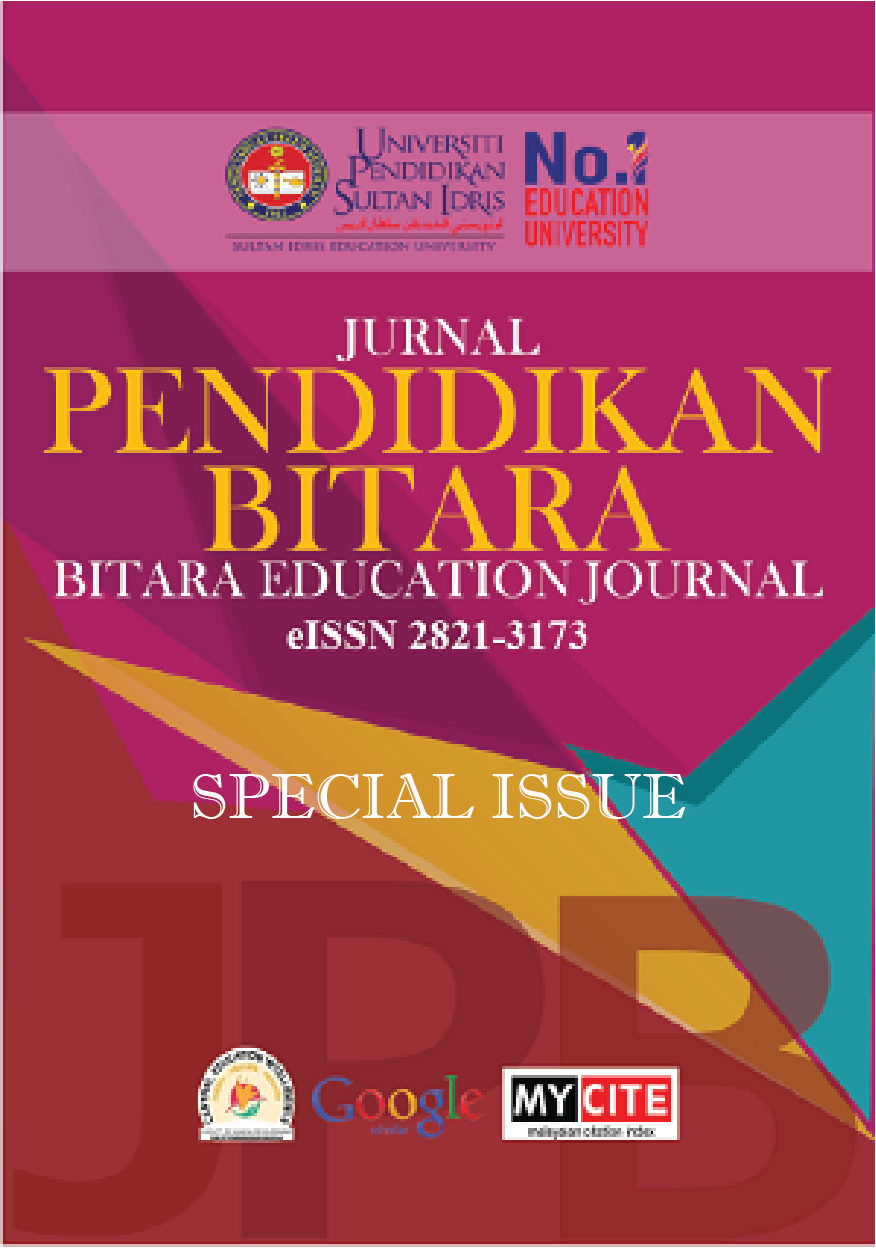Implementation of Banana Circle Based on Steam Project Approach in Increasing Socioemotional Development among Preschool Pupils
Pelaksanaan Banana Circle berasaskan Pendekatan Steam Projek dalam meningkatkan Perkembangan Sosioemosi Murid Prasekolah
DOI:
https://doi.org/10.37134/bitara.vol15.sp.11.2022Keywords:
STEAM Project Approach, STEAM Teaching, Preschool, SocioemotionalAbstract
Banana Circle is a teaching using the STEAM project approach. This approach needs to be applied by teachers for the successful implementation of 21st-century education. However, teachers in preschool have difficulty implementing STEAM teaching as there are no clear guidelines on the implementation of STEAM teaching. So, the implementation of the Banana Circle in this study is to identify it as an effective STEAM teaching and at the same time to improve the socioemotional development among preschool pupils. The implementation of Banana Circle involves nineteen pupils aged four, five, and six years old. Data collected through structured observations during the three-step STEAM teaching project (1) STEAM Language Conversations, (2) Finding STEAM anywhere, and (3) STEAM Future. The findings were obtained in quantitative analysis using Statistical Package for the Social Sciences (SPSS) 22.0 to get the mean and standard deviation values. Research findings showed that six-year- olds had higher socioemotional development in terms of emotional maturity and cooperation. Results showed five-year-olds are dominant in the accountability aspect while four-year-olds are more dominant in self-reliance, courage, and friendship. The conclusion, Banana Circle can improve the socioemotional development of preschoolers.
Downloads
References
Bahagian Pembangunan Kurikulum KPM. (2016). Kurikulum Standard Prasekolah Kebangsaan Semakan 2017. Putrajaya. Kementerian Pendidikan Malaysia
Cook, K., Bush, S., Richard, C. Jr., & Dan, E. (2020). Development of elementary teachers’ science, technology, engineering, arts, and mathematics planning practices. School Science and Mathematics, 120, 197–208.
https://doi.org/10.1111/ssm.12400
D.A. Sousa and T. Pilecki. (2013). From STEM to STEAM: using brain-compatible strategies to integrate the arts. United Stated. SAGE Publication Ltd.
DeJarnette, N.K.,.(2018). Implementing STEAM in the early childhood classroom.
European Journal of STEM Education, 3(3), 18. https://doi.org/10.20897/ejsteme/3878
E.W. Robelen. (2018). Building STEAM: Blending the arts with STEM subjects. Education Week, vol. 31, pp 8
G.H. Im, Y.K. Jiar and R. Talib. (2019). Development of preschool social emotional inventory for preschoolers: A preliminary study. International Journal of Evaluation and Research in Education (IJERE), vol. 8, pp. 158-164
Gunter, L., Caldarella, P., Korth, B. B., & Young, K. R. (2012). Promoting social and emotional learning in preschool students: A study of Strong Start Pre-K. Early Childhood Education Journal, 40 (3), 151-159
H. Sharapan. (2012). From STEM to STEAM: How early children educators can apply Fred Rogers Approach Young Children, vol. 67, pp 36–40. 2012.
Jamil, F. M., Linder, S. M. and Stegelin, D. A. (2018). Early childhood teacher beliefs about STEAM education after a professional development conference. Early Childhood Education Journal, 46(4), 409-417. https://doi.org/10.1007/s10643-017-0875-5
Kim, Y., & Park, N. (2012a). Development and application of STEAM teaching model based on the Rube Goldberg’s invention. In Computer science and its applications (pp. 693–698). The Netherlands: Springer.
L. Katz. (2010).STEM in the early years. SEED Paper for Early Childhood Research and Practice, vol 3, pp. 1–3
McClellan, Diane E. & Katz, Lilian G. (2001). Assessing young children's social competence. ERIC Clearinghouse on Elementary and Early Childhood Education Urbana IL.
Miller, J., & Knezek, G. (2013). STEAM for student engagement. In R. McBride & M. Searson (Eds.), Proceedings of Society for Information Technology & Teacher Education International Conference 2013 (pp. 3288–3298). Chesapeake, VA: Association for the Advancement of Computing in Education (AACE). Retrieved from http://www.learntechlib.org/p/48602
Piro, J. M. (2010). Going from STEM to STEAM: The arts Mottan, K. (2019). TEACHER ASSISTANTS AND THEIR ROLES IN PRESCHOOLS: A CONCEPTUAL FRAMEWORK FOR MALAYSIAN PRESCHOOLS (63 - 68). Jurnal Pendidikan Bitara UPSI, 6(1), 63-68. Retrieved from https://ejournal.upsi.edu.my/index.php/JPB/article/view/2427 have a role in America’s future too. Education Week, 29(24), 28–29.
Quigley, C. F., & Herro, D. (2016). Finding the joy in the unknown: implementation of STEAM teaching practices in middle school science and math classrooms. Journal of Science Education and Technology, 1-17.
Rhoades, B. L., Warren, H. K., Domitrovich, C. E., & Greenberg, M. T. (2011). Examining the link between preschool social–emotional competence and first grade academic achievement: The role of attention skills. Early Childhood Research Quarterly, 26 (2), 182-191.
Robelen, E. W. (2011). Building STEAM: Blending the arts with STEM subjects. Education Week, 31(13), 8. Retrieved from http://ezproxy.rowan.edu/login?url=http://search.proquest.com/docview/910218761?accountid=13605
Schirrmacher, R. (2002). Art and creative development for young children. Clifton Park, NY: Thomson Delmar Learning.
Sumayyah Aimi Mohd Najib, Hanifah Mahat and Nur Hidayah Baharudin. (2020). The level of STEM knowledge, skills, and values among the students of bachelor’s degree of education in geography. International Journal of Evaluation and Research in Education, vol. 9, pp. 69-76
Suraya, Norsalawati & Nasir. (2017). Integration of STEM education in Malaysia and why to STEAM. International Journal of Academic Research in Business and Social Sciences. Advance online publication. doi: 10.6007/IJARBSS/v7-i6/3027
Tarnoff, J. (2010). STEM to STEAM: Recognizing the value of creative skills in the competitive debate. Huffington Post. Retrieved from
http://www.huffingtonpost.com/john-tarnoff/ stem-to-steam-recognizing_b_756519.html
Unit Pelaksanaan and Prestasi. (2017). “Pelan pembangunan pendidikan Malaysia 2013-2025: Laporan tahunan 2017”, Putrajaya: Kementerian Pendidikan Malaysia
Van Meeteren, B., & Zan, B. (2010). Revealing the work of young engineers in early childhood education. Early Childhood Research and Practice. Collected Papers from the SEED (STEM in Early Education and Development) Conference. Retrieved from http:// ecrp.uiuc.edu/beyond/seed/zan.html
Wynn, T., & Harris, J., (2012). Toward a Stem + Arts curriculum: Creating the teacher team. Journal Art Education, 65(5), 42-47. https://doi.org/10.1080/00043125.2012.11519191
Yakman, G (2010, July 8). 2006-2010 What is STEAM: short overview paper. Dicapai daripada https://steamedu.com/downloads-and-resources/
Yusriza Mohamd Yusof, Afida Ayob & Mohamad Hanif Md Saad. (2021). Penggunaan teknologi kejuteraan dalam Pendidikan STEM Bersepadu. Jurnal Kejuruteraan, 33(1), 1-11.https://doi.org/10.17576/jkukm-2020-33(1)-01
Zahiroh Awang, Nooraida Yakob, Aswati Hamzah & Mohd Mernan Talling. (2020). Exploring STEAM teaching in preschool using Fred Rogers approach. International Journal of Evaluation and Research in Education (IJERE), vol.9 (4), pp. 1071-1078. DOI: 10.11591/ijere.v9i4.20674
Z.Mengmeng, Y.Xiantong and W.Xinghua. (2019). Construction of STEAM curriculum model and case design in Kindergarten. American Journal of Education Research, vol 7, pp. 485-490





